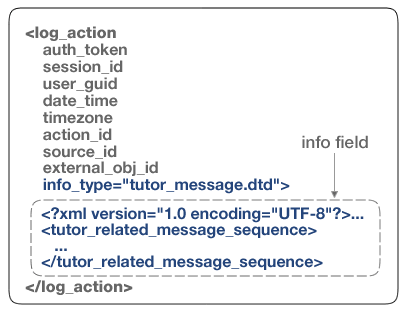The root element of an XML file or message that conforms to the
tutor message format is the <tutor_related_message_sequence>. The XML Schema
Definition defines the possible contents of this element.
Here's how your XML should start and end:
<?xml version="1.0" encoding="UTF-8"?>
<tutor_related_message_sequence
xmlns:xsi='http://www.w3.org/2001/XMLSchema-instance'
xsi:noNamespaceSchemaLocation='http://learnlab.web.cmu.edu/dtd/tutor_message_v4.xsd'
version_number="4"
>
<!-- Tutor message elements go here -->
</tutor_related_message_sequence>
As in the above code, start your XML with:
-
an XML prolog (XML version, encoding);
-
the opening tag for the
tutor_related_message_sequenceroot node; -
a qualifier for the schema instance namespace (
xmlns:xsi); -
a pointer to the schema itself (
xsi:noNamespaceSchemaLocation), which references the schema file; and -
a
version_numberattribute with value4—this is the version of the Tutor Message format described in this document.
![[Note]](images/note.gif) | Note |
|---|---|
|
The DataShop will continue to accept logs that conform to version 2 of the Tutor Message format, as well as logs conforming to version 4. |
Be sure the data in your XML complies with the encoding specified in the XML prolog. UTF-8 is not required; other ISO encodings are permitted.
End your XML by closing the root element, </tutor_related_message_sequence>.
If you are using the older DTD version of the schema, your XML should start and end like this:
<?xml version="1.0" encoding="UTF-8"?> <!DOCTYPE tutor_related_message_sequence SYSTEM "http://learnlab.web.cmu.edu/dtd/tutor_message_v4.dtd"> <tutor_related_message_sequence version_number="4"> <!-- Tutor message elements go here --> </tutor_related_message_sequence>
